
 |
| China Photo Expeditions 2018 |
|---|
| 17-Day Xinjiang - Silk Road Expeditions |
| Departure on October 17 |
| Group size: 8-12 |
| Hightlights: |
See the famous International Grand Bazaar and Livestock Sunday Bazaar. |
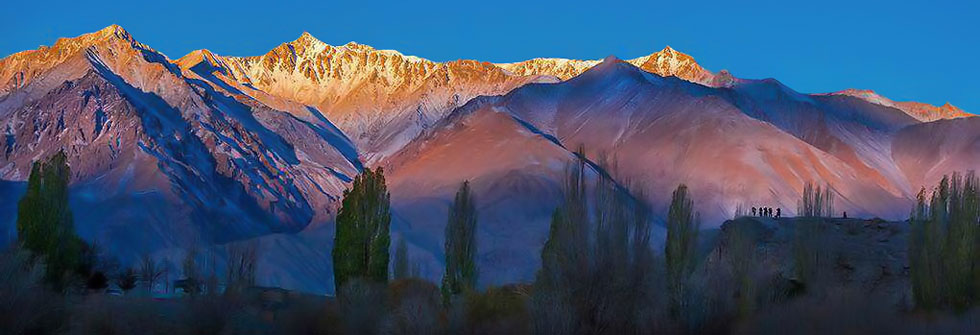 |
| Date | Places | Tour | Hotel | Note |
|---|---|---|---|---|
| 10/17 | Portland/Seattle | Leave PDX at 10:15am, arive Seattle at 11:10am. Alaska Air #2148. LV SEA at 2:pm, Ahainan Airlines #496 | Air | |
| 10/18 | Sea/Beijing | Arrive Beijing at 4:35pm. LV Beijing at 9:05pm, Hainan Air #7345 | Air | |
| 10/19 | Beijing/Urumqi | Arrive Urumqi at 1:15am. Transfer to Hotel. Visit Xingjiang International Grand Bazaar in the afternoon. | ***** | Bus |
| 10/20 | Urumqi | Riding to the famous scenic spot Heavenly Lake to enjoy the charm of the world heritage of nature. Heading back to Urumqi after lunch. A fabulous ethnic show in Xinjiang grand theater in the afternoon (option). | ***** | Bus |
| 10/21 | Urumqi/Kashgar | Catch a morning flight to Kashgar. Heading straight to Sunday bazaar both of livestock and the commodity bazaar. Heading to fragrant concubine mausoleum, handy craftsman street and the old town. | ***** | Air/Bus |
| 10/22 | Kashgar/Taskurgan | Heading to Pamir plateau to visit the Karakul lake (Att 11500F) , we will see the father of the glacier, Muztag Ata (ATT: 7509M) reflecting on the lake. We will also see the Brenko white sandy lake on the way. Sunset at Golden Grass Marshland (Att 10500F). | *** | Bus |
| 10/23 | Taskurgan | Taskurgant Sunrise on the Taskurgan castle. Visit to a Tajik family, stroll around to shoot more pics of local people, and scenery in vicinity. | **** | Bus |
| 10/24 | Taskurgan/Kashgar | Review the imposing scenery like the snow-caps, the glacier, the white sand lake, and the colorful mountains along Karakrum high way. Stop by the little towns on the way. Visit the Atigar grand mosque and the night food market. | ***** | Bus |
| 10/25 | Kashgar/Aheqi | Heading to Aheqi county, visit the village of eagle and falcon village of China. Hit Aheqi in the afternoon. Visit the hunter’s home. The local people are different from Uyhgur and Tajik, as they are Kyrgyz people. | **** | Bus |
| 10/26 | Aheqi/Shaya | Heading to a hunting site to see how the local hunters using their eagels and falcons to hunt for birds and rabbits. Heading to Shaya town after lunch. | **** | Bus |
| 10/27 | Shaya | Visit Sun Island or World Populus Euphratica Trees Park. | **** | Bus |
| 10/28 | Shaya/Kuqa | Heading to Kuqa to visit the grand bazaar, the great mosque, as well as the Subashi ancient city. | ***** | Bus |
| 10/29 | Kuqa | Heading to mysterious grand canyon of Tianshan mountain. Visit the imposing salt water valley along the ride. | ***** | Bus |
| 10/30 | Kuqa/Lunnan/Luntai | Heading to Lunnan to see the vast Taklamakent desert, and visit the euphratica tree park which is biggest populus euphratica park in China. You might happen to meet the shepherd shepherding his animals across the trees and dust. | **** | Bus |
| 10/31 | Luntai/Turpan | Heading to Turpan via Korla in the morning. Hitting Turpan in the afternoon. Visit Maza village. | **** | Bus |
| 11/01 | Turpan/Shanshan /Turpan |
Heading to Shanshan to visit Kumtag desert scenic spot, taking photos of camels. Go back to Turpan visiting Jiaohe ancient city ruins in the afternoon. | **** | Bus |
| 11/02 | TurpanUrumqi | Visit Karez Irrigation (one of three great ancient projects) in the morning. Ride back to Urumqi. We may visit the Akan-teke horse and wild horse collection clubs (option) if we have time. | ***** | Bus |
| 11/03 | Urumqi/US | Leave Urumqi at 9:05am, arrive Beijing at 12:45pm. Hainan Air #7346, LV Beijing at 3:50pm, arrive Seattle at 11:30am, Hainan Air #495. Leave Seattle at 2:55pm, Arr PDX at 3:50pm, Alaska Airlines #2697 | Bus/Air | |
| Pre-Silk Road tour | ||||
| 10/14 | PDX/SEA | Leave PDX at 10:15am, arrive Seattle at 11:10am. Alaska Air #2148. LV SEA at 2:00pm, Hainan Airlines #496 | Air | |
| 10/15 | SEA/Beijing/Lanzhou | Arrive Beijing at 4:35pm. LV Beijing at 7:25pm, Arrive Lanzhou at 10:00pm. Transfer to hotel. | **** | Air/Bus |
| 10/16 | Lanzhou/Zhangye | Fly to Zhangye, 12:15pm/1:30pm, FLT #ZH5007. Check in hotel. Zhangye Geopark for sunset. | **** | Air/Bus |
| 10/17 | Zhangye/Jiayuguan /Dunhuang |
Sunrise at Zhangye Geopark. Bus to Jiayuguan, visit Jiayuguan Great Wall and Overhanging Great Wall. Bus to Dunhuang | **** | Bus |
| 10/18 | Dunhuang/Urumqi | Visit Mogao Caves, Echoing-Sand Mountain and Crescent Lake. Fly to Urumqi at night 11:15pm, FLT QU2586. Arrive Urumqi at 12:55am on Oct. 19. | ***** | Bus/Air |
| 11/03 | Urumqi/US | Leave Urumqi at 9:05am, arrive Beijing at 12:45pm. Hainan Air #7346, LV Beijing at 3:50pm, arrive Seattle at 11:30am, Hainan Air #495. Leave Seattle at 2:00pm, Arr PDX at 2:55pm, Alaska Airlines #2395 | Air |
| Price: $4,290/person |
Single room supplement: $650
|
| Side trip price: $1100/perosn |
| Single room supplement for side trip $150 |
Departure will be on October 17, 2018 (side trip departure on October 14, 2018) |
| Tour package features: |
|
 |
| Xinjiang Uyghur Autonomous Region |
|---|
Xinjiang Uyghur Autonomous Region is a provincial-level autonomous region of China in the northwest of the country. It is the largest Chinese administrative division and the eighth largest country subdivision in the world, spanning over 1.6 million km2 (640,000 square miles). Xinjiang contains the disputed territory of Aksai Chin, which is administered by China. Xinjiang borders the countries of Mongolia, Russia, Kazakhstan, Kyrgyzstan, Tajikistan, Afghanistan, Pakistan and India. The rugged Karakoram, Kunlun, and Tian Shan mountain ranges occupy much of Xinjiang's borders, as well as its western and southern regions. Xinjiang also borders Tibet Autonomous Region and the provinces of Gansu and Qinghai. The most well-known route of the historical Silk Road ran through the territory from the east to its northwestern border. In recent decades, abundant oil and mineral reserves have been found in Xinjiang, and it is currently China's largest natural gas-producing region. |
| Urumqi is the capItal city of Xinjiang Uyghur autonomous region in northwest China, with a population of 4 million. As home to 49 minority ethnic groups, this graceful prairie city is an important stop along the ancient Silk Road, leading to Central Asia and even as far as Europe. It’s regarded as the farthest city from any ocean in the world. In the middle of Bogda Peak, 68miles east of Urumqi, nestles Heavenly Lake. Covering 1.89 square miles, this crescent-shaped water area deserves its name, Pearl of Heavenly Mountain (Tianshan Mountain). With melted snow as its source, Heavenly Lake enjoys crystal water. |
||
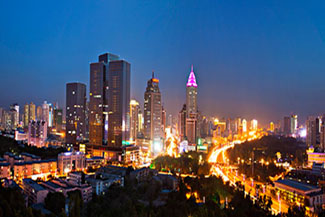 |
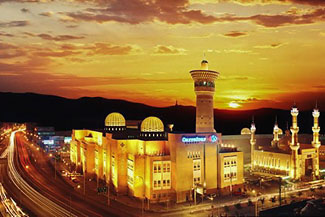 |
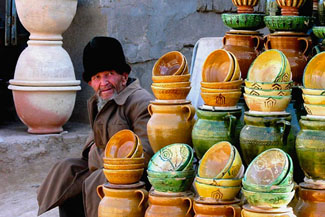 |
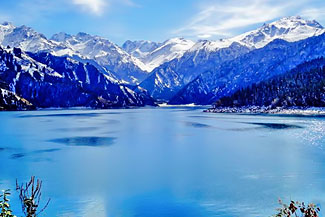 |
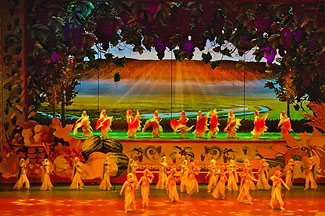 |
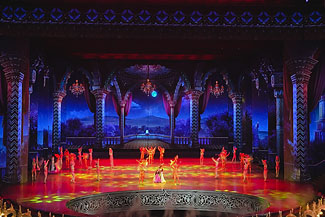 |
Kashgar is an oasis city in Xinjiang and is the westernmost Chinese city, located near the border with Kyrgyzstan, Tajikistan, Afghanistan, and Pakistan. With a population of over 500,000, Kashgar has a rich history of over 2,000 years and served as a trading post and strategically important city on the Silk Road between China, the Middle East, and Europe. |
||
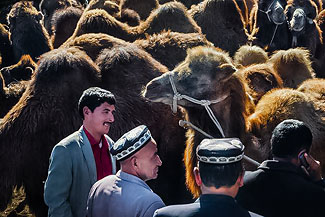 |
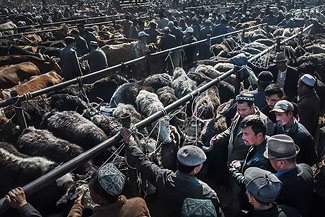 |
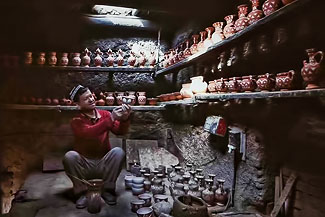 |
Taskurgan means “Stone Tower” in the Turkic languages. Tashkurgan is the seat of Tashkurgan Tajik Autonomous County where is located in the eastern part of the Pamir Plateau. It is situated at an altitude of 10,140 ft on the borders of both Afghanistan and Tajikistan, and close to the border of Kyrgyzstan and Pakistan. Tashkurgan is a market town for sheep, wool and woolen goods, particularly carpets, and is surrounded by orchards. The majority population in the town are ethnic Mountain Tajiks. Today Tashkurgan is on the Karakoram Highway which follows the old Silk Road route from China to Pakistan. |
||
|
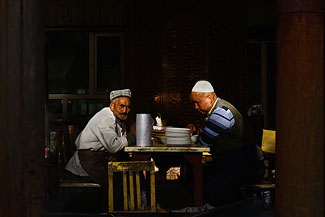 |
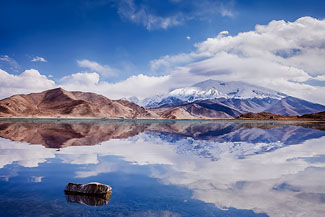 |
|
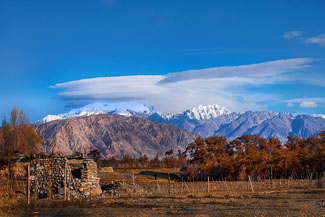 |
 |
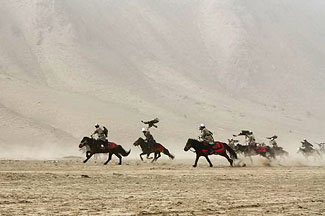 |
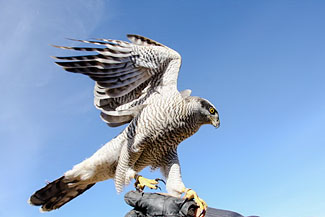 |
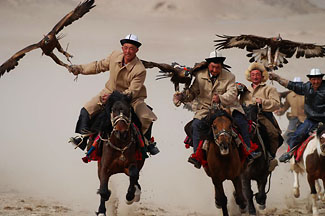 |
Kuqa (pronounced ku-cheh) is a small and important town along the ancient Silk Road in the Han Dynasty, and it is a largely Uigur population. The fourth-century linguist and scholar Kumarajiva , who came from here, was one of the most famous of all Chinese Buddhists. By the early Tang Dynasty, Kuqa was a major centre of Buddhism in China. Reported the existence of two huge Buddha statues, twenty-seven meters high, guarding its entrances. The city even had its own Indo-European language. With the arrival of Islam in the ninth century, however, this era finally began to draw to a close, and today only a few traces of Kuqa's glorious past remain. |
||
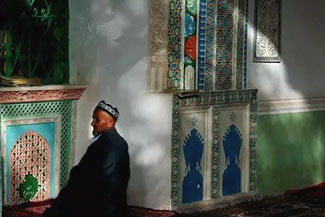 |
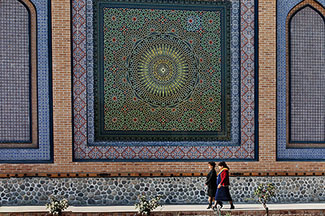 |
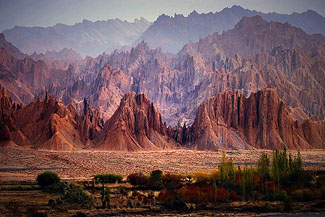 |
Taklimakan Desert, The Desert in northwest China fills the expansive Tarim Basin between the Kunlun Mountains and the Tibetan Plateau to the south and the Tian Shan (Celestial Mountains) to the north. It is china’s largest sand desert and one of the eight biggest deserts in the world. The Taklimakan’s rolling sand dunes stretch out over 3, 376, 000 square kilometers. This desert is located farther from the ocean than almost any other place on Earth. As a result, some parts of the region receive less than 10 millimeters of precipitation a year. |
||
 |
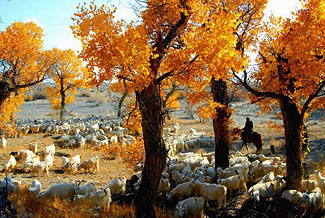 |
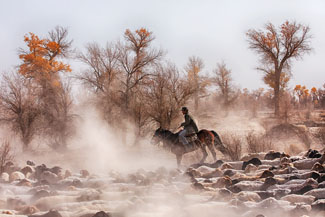 |
 |
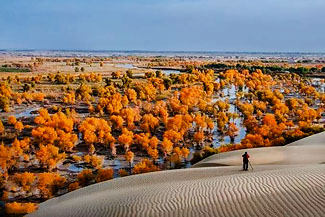 |
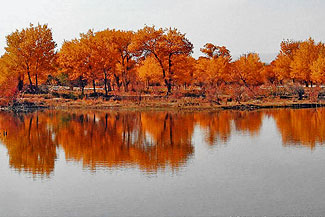 |
Turpan: Also known as Turfan or Tulufan, is a prefecture-level city located in the east of Xinjiang, China. It has an area of 26,766 sq mi and a population of 570,000 (2003). It is an important trade center located along the Silk Road. It owes its curious longevity to an ingenious irrigation system once prevalent throughout Central Asia. Here 5,000 kilometres of underground tunnels channel glacier water from the high mountains down to the valley, sustaining a population of over 250,000 people and the grapes for which the area is famed.Surrounding the town are numerous fascinating sites including ruined desert cities, ancient Buddhist caves, and Jiaohe Ruins, World heritage of history, ancient remains in the middle of desert. We are going to visit the Mount Sand Park which is located at Kumtag Desert in Shanshan county,taking photos of a row of camels crossing the desert. Kumtag desert has been developed as a tourist resort where visitors can have a full view of the magnificence of the desert without actually venturing out into it. |
||
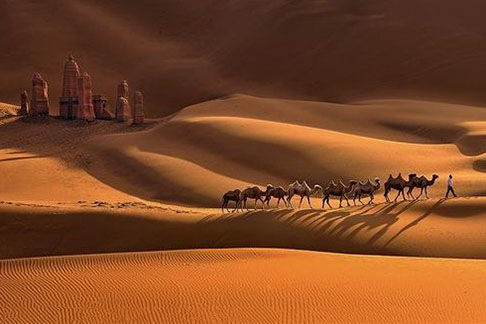 |
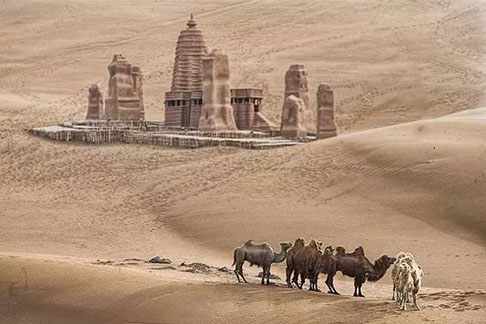 |
 |
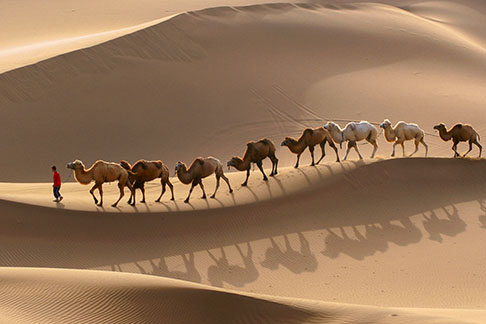 |
| Su’s Note: I took a similar route to Xinjiang in 2016 in the same season. There were a lot of photo opportunities, such as the unique White Sand Lake, Populus Park and so on. Especially, when I visited the bazaars, the old towns, and stopped on the roads. It was the first time to see the Xinjiang people making and baking the Nan bread (Xinjiang pizza), witness how they roasted lamb, and how they used their special way of bargaining in the markets. I saw from time to time a large drying red peppers, looking like the red “sea”, but I also often saw a large white cotton field. The sheep in Populus forest shuttle, also ran on the road sharing the space with me. I found the fruit in Xinjiang were very sweet and juicy, the “BBQ” lambs were very tasty and inexpensive. There were many check points on the road, and when I checked in hotels, my luggage needed to be gone through the X-ray machine. I saw armed police on guard at every block of streets, and I felt very safe. Xinjiang is located Northwest China, it uses its own time zone, which is two hours later than Beijing time. | |
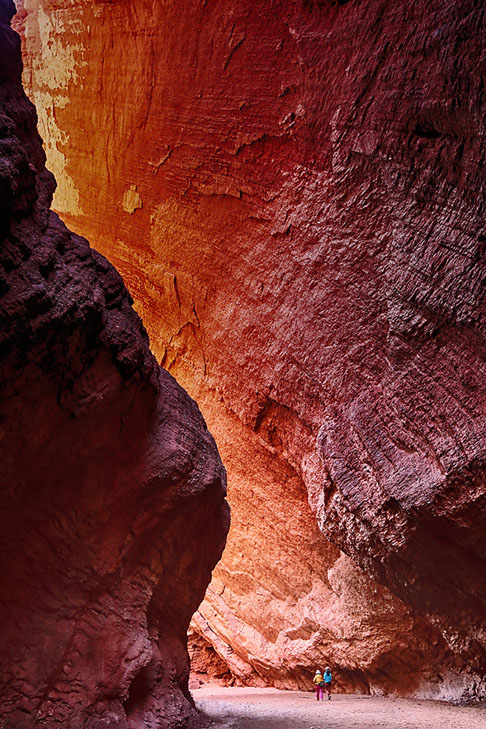 |
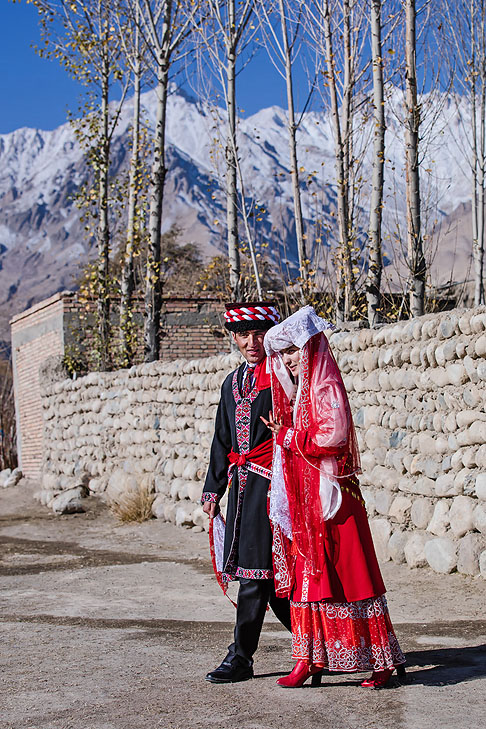 |
| Pre-Silk Road Tour Information-- Zhangye | |
Zhangye, is a prefecture-level city in central Gansu Province in China. It borders inner Mongolia on the north and Qinghai on the south, midway through Hexi Corridor. Its central district is Ganzhou, formerly a city of the Western Xia and one of the most important outposts of western China. Population:4.46 million, total area: 16,177 sq mi. |
|
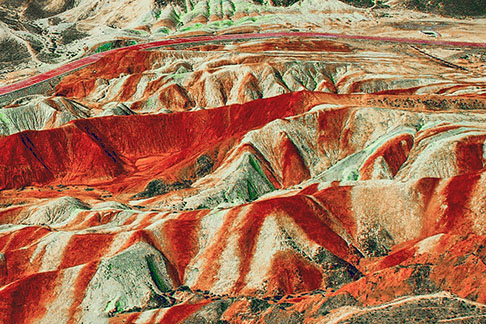 |
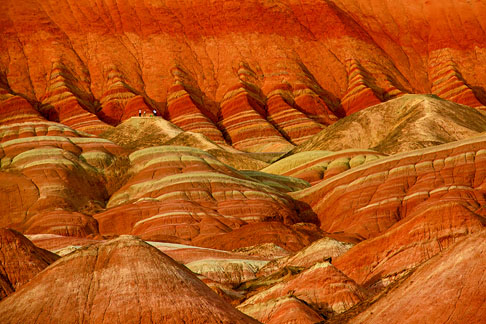 |
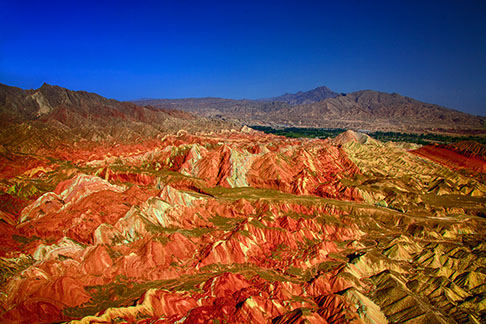 |
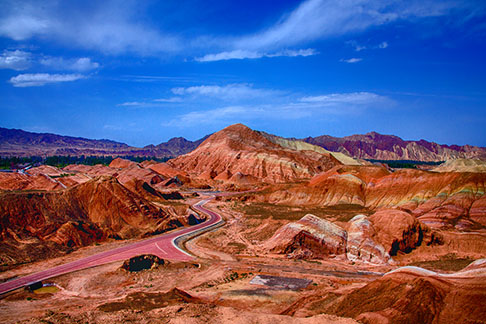 |
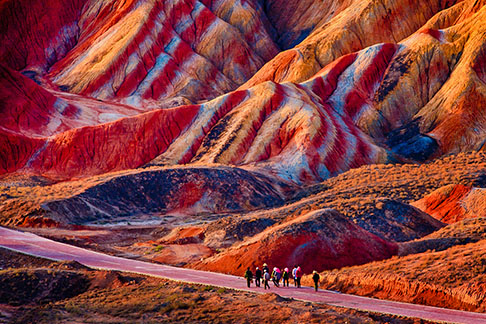 |
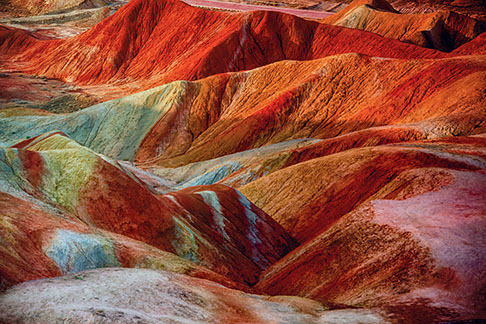 |
Jiayuguan |
||
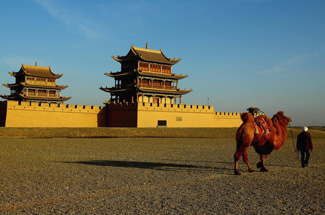 |
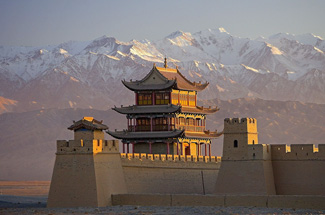 |
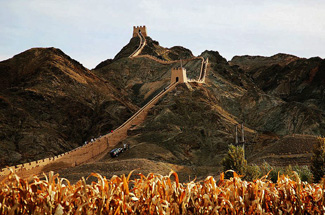 |
Dunhuang |
||
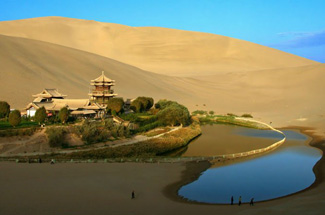 |
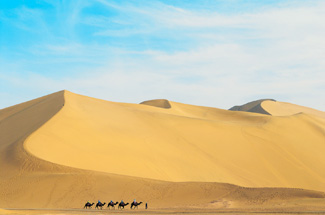 |
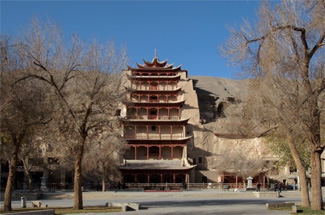 |